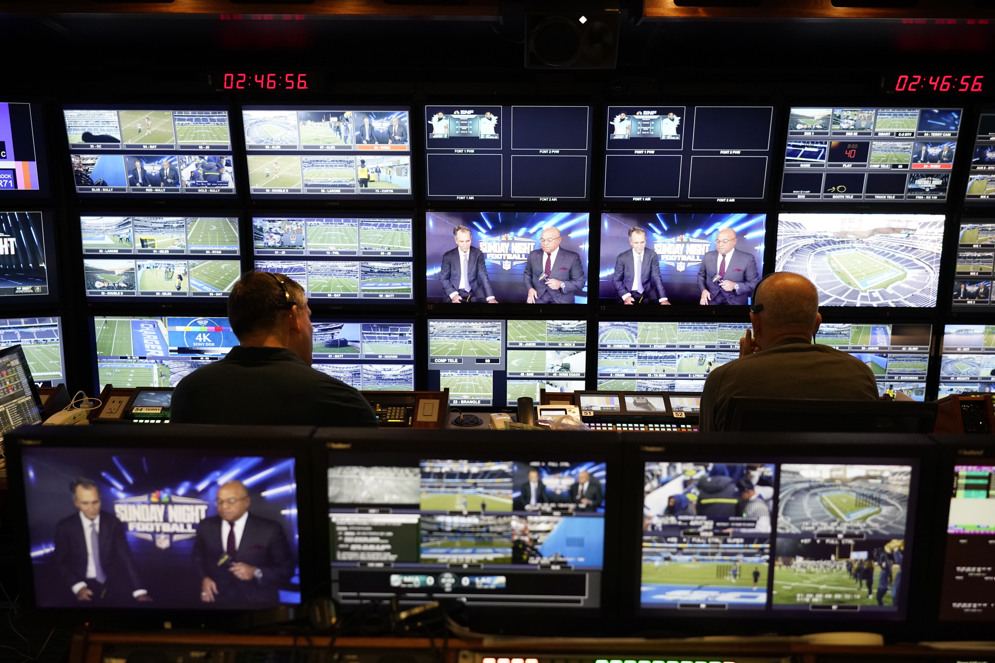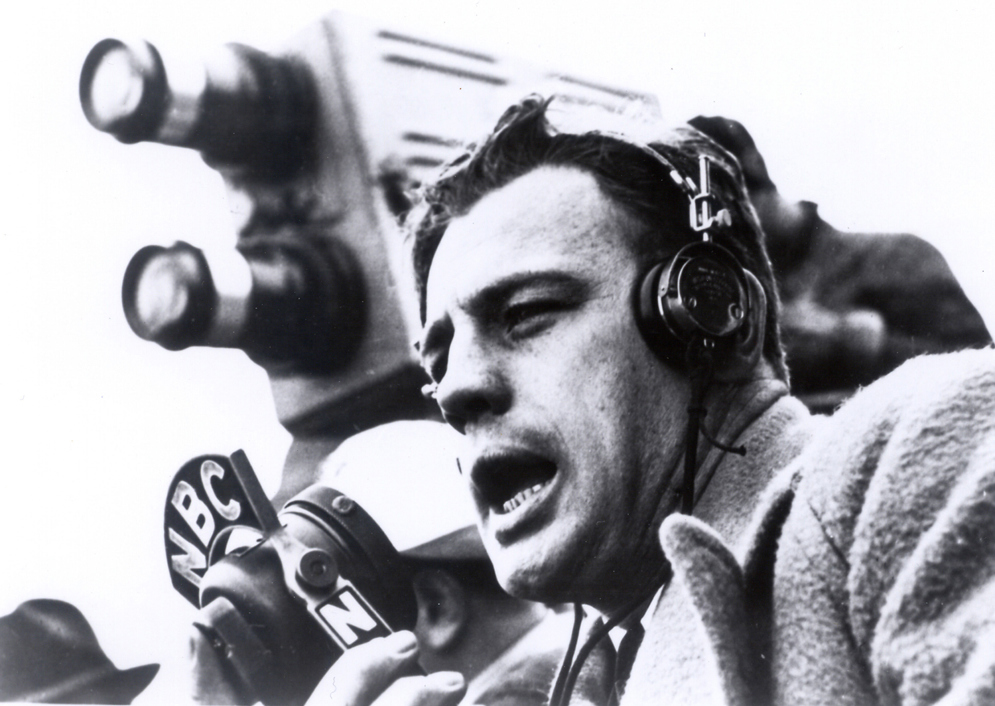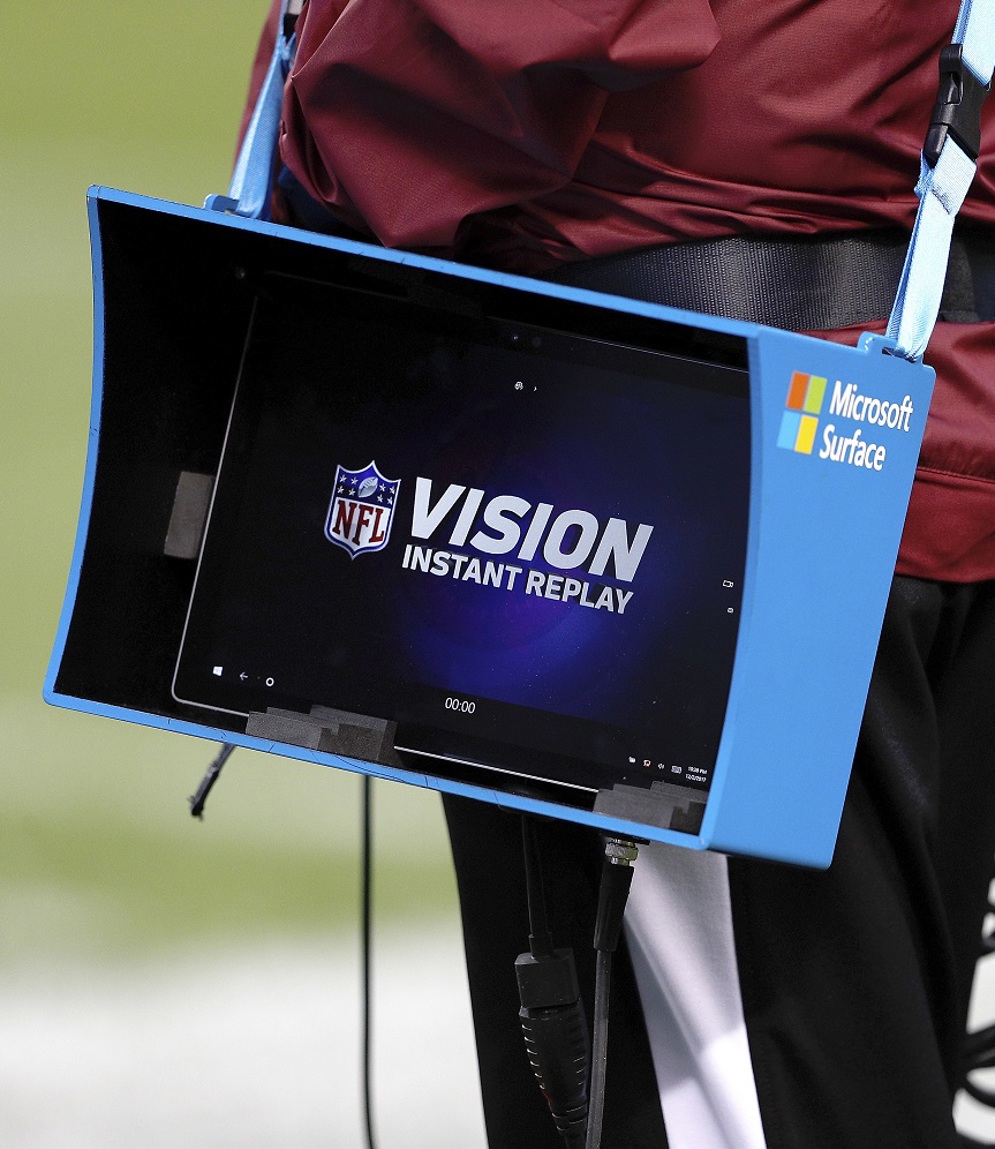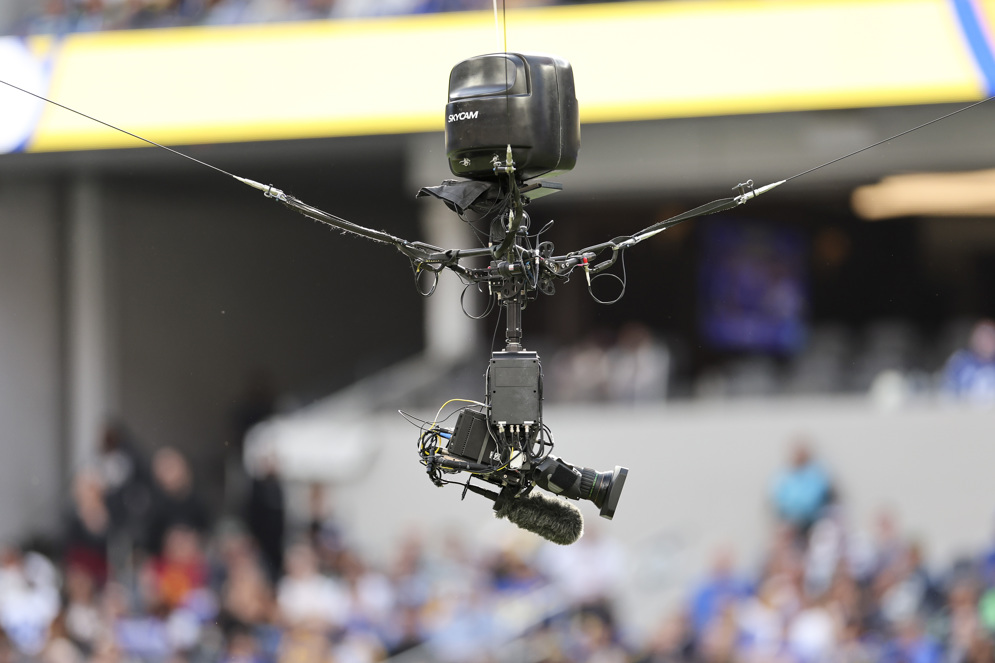Impact of Television
How television has changed the game.
How television has changed the game.

Producer Robert Hyland and director Drew Esocoff work inside the NBC Sports trailer in preparation for the network's "Sunday Night Football" broadcast in 2022. Every Sunday night during the season, his crew produces what fans see from multiple cameras deployed throughout the stadium. (AP/Jae C. Hong)
Today, 16 million fans tune in for a typical regular-season game. NFL games dominate weekly television ratings each fall, and the league evenly divides the revenue from multibillion-dollar television contracts among all 32 clubs. Each game is a major production, with broadcasters deploying 12 to 20 cameras and 150 to 200 employees for regular-season contests.
In 1939, NBC was the first network to televise a pro football game, using two cameras and about eight staffers. Shortcomings in the available technology presented challenges for airing the contest between the Philadelphia Eagles and the Brooklyn Dodgers.
“It was late in October on a cloudy day, and when the sun crept behind the stadium there wasn’t enough light for the cameras. The picture would get darker and darker, and eventually it would be completely blank and we’d revert to a radio broadcast,” play-by-play announcer Allen “Skip” Walz recounted in Football Digest.

NBC play-by-play announcer Allen "Skip" Walz used two cameras for the first-ever televised NFL game, including one that operated right over his shoulder in the stadium’s mezzanine section. (Pro Football Hall of Fame)
The network broadcast the game to the roughly 1,000 TV sets in New York City at the time and to displays in the RCA Pavilion at the New York World’s Fair. NBC continued to air games and — though football on TV wouldn’t fully take off for a few more years — the seed was planted.
After World War II, U.S. consumers began buying televisions in droves, and televised NFL games became more common. Landmark moments in the television’s relationship with pro football followed, including the first nationally televised game, “the greatest game ever played,” the first leaguewide TV contract, the “‘Heidi’ Bowl” and the births of the Super Bowl and “Monday Night Football.”
Cumulatively, those events and others cemented the relationship. The impact on the league has been remarkable, in both obvious and subtle ways.
Televised games fueled the dramatic increase in the NFL’s popularity and profitability. Fans soon set aside time each week to watch their favorite teams play on Sundays. Games were eventually added to other days and moved to prime time. Television elevated the Super Bowl from sporting event to de facto national holiday: Super Bowl LVI, on Feb. 15, 2022, topped 112 million viewers.
Congress’ 1961 decision to allow sports leagues to negotiate their own collective television contracts let the NFL set up a system to share annual television revenue equally among all teams.
Before then, big-market teams like the New York Giants could earn 10 times as much money as small-market teams like the Green Bay Packers, which gave the Giants much more cash to sign the best players. But by equally distributing the television revenue — in addition to sharing revenue from other sources, such as merchandising and ticket sales — the league ensures that every team has the financial ability to compete on and off the field.
The NFL’s revenue sharing has maintained competitiveness across all teams and has helped the league avoid financial disparities faced by other sports that gave teams nearly insurmountable advantages. Other major sports leagues have modified their revenue sharing since 2000 to adopt systems more like the NFL’s.
All of this contributes to greater parity among teams, competitive games and more teams in the playoff hunt each year — improving the game for fans, players, owners and the league’s broadcast partners.
Perhaps the biggest impact and symbiosis in the NFL-television relationship involve advances in the technology that enabled the league to grow and flourish and led to its rise to prominence. Since that first game in 1939, broadcasters and the NFL have continued to innovate and push the limits of how television can enhance the NFL experience.

Deeper Dive: Learn more about the history of instant replay
Instant replay, initially used for just one play during the Army-Navy game in late 1963, soon would become ubiquitous for NFL broadcasts, especially when slow motion and freeze-frame capabilities were added and enhanced.
Replay made games more entertaining. It provided a natural filler for the sport’s many breaks in play and could be used to highlight hard hits, battles in the trenches, great runs and catches, and other key plays. Broadcasters also used replay to better explain the game’s nuances, creating greater fan awareness, understanding and involvement.
Inevitably, instant replay became commonplace, increasing the pressure on the NFL to find a way to use the technology to help game officials make the correct calls.
Replay provided broadcasters and viewers with visual evidence, in slow motion, to second-guess the judgment calls officials made on the spot at full speed. Howard Cosell, one of the most influential sportscasters of his day, captured the frustration while in the broadcasting booth for “Monday Night Football.” After an apparently incorrect call on a catch in the end zone, the exasperated commentator declared to the national audience: “That’s absurd; all they gotta do is roll the tape!”
But the technology wasn’t advanced enough yet to quickly and efficiently review plays. The NFL tested replay review during the 1978 preseason and determined that to get the calls right, it needed at least 12 cameras to have enough angles on every play. But any system would rely on the broadcast feed, and the networks were not yet using that many cameras.
After broadcasters began using more cameras — and other technology improved — the NFL owners approved instant replay reviews in 1986. They killed the system in 1992, citing delays and incorrect calls, but brought it back for good in 1999.
As television added more and better cameras, instant replay reviews improved too. Today’s high-definition video gives officials a clearer view of what actually happened. The league’s state-of-the-art NFL Vision software processes game footage and isolates plays for replay, delivering high-definition images in seconds to officials in Art McNally GameDay Central in New York and at the stadiums.
This is symbiosis in action. Television’s technological advances, embraced by the NFL, are used to improve the quality of the product the broadcasters are showing: the game.
Television’s impact on the game also can be realized in other ways — by teams and by the league.
It didn’t take coaches long to realize the power of cameras and film as coaching tools. Cleveland Browns coach Paul Brown became the first coach to use film to scout other players and coaches and to evaluate his own players.

The SkyCam is pictured during an NFL game between the Los Angeles Rams and the Seattle Seahawks in 2023. (Ben Liebenberg via AP)
Today, every team uses coaches’ tapes. In addition to the network feed, the NFL captures game action from two cameras positioned high above the field in every stadium. The “All-22” angle captures every player on the field in a single shot, and the “End Zone” camera provides a downfield view as the play unfolds. The league now makes these resources available to fans through NFL Game Pass as well.
The proprietary NFL Vision software also enables the league to use game footage to help protect players and evaluate both the officials and the rules of the game.
At each game, an independently certified trainer contracted by the league uses NFL Vision to monitor the broadcast feed and identify potential injuries. In plays during which a possible injury occurs, this spotter immediately notifies on-field medical staff and can even transmit a replay to a sideline monitor for the trainer or doctor to view.
The Officiating Department reviews network television footage and coaches’ tape to evaluate officials from every angle. The software also allows GameDay Central technicians to isolate plays that merit further review and bring them to the league’s attention. They can also store and collect important game data.
The stored footage from the television feed even contributes to the NFL’s rule-making: League officials involved in the process study game film to help them research what to do and track trends, as they did in examining kickoff returns to determine the factors contributing to injuries on the play.
Television also improves the experience for fans attending the games. Technology has raised the quality of the at-home viewing experience so high that the NFL and its clubs always search for ways to provide a better in-stadium experience.
Oversized video scoreboards have become the norm in all NFL stadiums. Fans rely on them for replays and closer views of game action. Home teams use them to fire up the crowd and entertain the fans between plays.
Clubs keep building bigger and better scoreboards. Cowboys Stadium (now AT&T Stadium) in Dallas opened in 2009 with the then-largest LED scoreboard — 72 feet high, 160 feet wide. In a stadium “arms race,” the Jacksonville Jaguars unveiled two 62-feet-high, 362-feet-wide, high-definition LED scoreboards for the 2014 season.
Of course, NFL football has been very good for TV too. The games are ratings behemoths that provide networks with advertising dollars, along with viewership that benefits the networks’ promotions and non-NFL programming. Like any good relationship, this one remains a two-way street, benefiting both the broadcasters and the game.